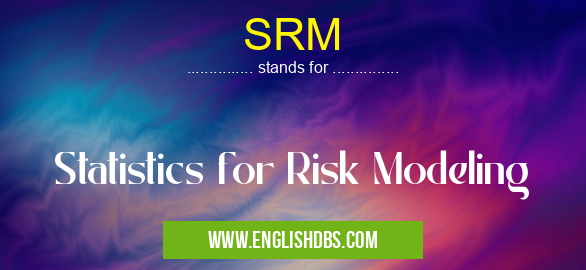What does SRM mean in STATISTICS
SRM stands for Statistics for Risk Modeling. It is a branch of statistics that focuses on developing and applying statistical methods to assess and manage risks. SRM is used in a wide variety of fields, including finance, insurance, healthcare, and environmental science.

SRM meaning in Statistics in Academic & Science
SRM mostly used in an acronym Statistics in Category Academic & Science that means Statistics for Risk Modeling
Shorthand: SRM,
Full Form: Statistics for Risk Modeling
For more information of "Statistics for Risk Modeling", see the section below.
Methods used in SRM
SRM uses a variety of statistical methods to assess and manage risks. These methods include:
- Descriptive statistics: Used to summarize and describe data.
- Inferential statistics: Used to make inferences about a population based on a sample.
- Regression analysis: Used to predict the relationship between two or more variables.
- Time series analysis: Used to analyze data over time.
- Monte Carlo simulation: Used to generate random samples from a distribution and simulate the occurrence of events.
Applications of SRM
SRM is used in a wide variety of applications, including:
- Financial risk management: Assessing and managing the risk of financial losses.
- Insurance risk management: Assessing and managing the risk of insurance claims.
- Healthcare risk management: Assessing and managing the risk of adverse health outcomes.
- Environmental risk management: Assessing and managing the risk of environmental hazards.
Essential Questions and Answers on Statistics for Risk Modeling in "SCIENCE»STATISTICS"
What is SRM (Statistics for Risk Modeling)?
SRM is a specialized field of statistics that focuses on developing and applying statistical models to quantify and manage risk. It involves using historical data and statistical techniques to predict future outcomes and assess the likelihood and impact of uncertain events.
Why is SRM important in risk management?
SRM provides valuable insights into potential risks by quantifying their probability, severity, and interactions. This enables businesses and organizations to make informed decisions, allocate resources effectively, and mitigate losses by implementing appropriate risk management strategies.
What are the key concepts in SRM?
Key concepts include probability theory, statistical modeling, risk assessment, data analysis, and stochastic processes. SRM practitioners use these concepts to construct models that simulate risk scenarios and estimate their impact on a given system or process.
What are the different types of SRM models?
Common SRM models include:
- Traditional statistical models: Focus on identifying relationships between variables and predicting future outcomes.
- Machine learning models: Utilize algorithms to identify patterns and make predictions based on historical data.
- Monte Carlo simulation: Simulates random scenarios to estimate risk and uncertainty.
- Bayesian models: Incorporate prior knowledge and continuously update predictions as new data becomes available.
What industries use SRM?
SRM is widely used in various industries, including:
- Insurance and finance
- Healthcare
- Engineering
- Environmental assessment
- Risk management consulting
What are the benefits of using SRM?
SRM offers several benefits:
- Improved risk assessment and prediction
- Optimized decision-making under uncertainty
- Reduced financial losses and increased efficiency
- Enhanced stakeholder confidence and transparency
- Compliance with regulatory requirements
Final Words: SRM is a powerful tool that can be used to assess and manage risks in a wide variety of fields. By using statistical methods, SRM can help organizations to make informed decisions about how to allocate resources and mitigate risks.
SRM also stands for: |
|
| All stands for SRM |
